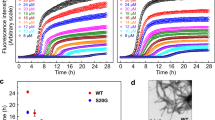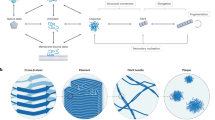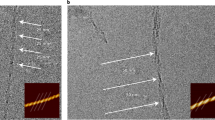Abstract
Many polypeptides can self-associate into linear, aggregated assemblies termed amyloid fibers. High-resolution structural insights into the mechanism of fibrillogenesis are elusive owing to the transient and mixed oligomeric nature of assembly intermediates. Here, we report the conformational changes that initiate fiber formation by β-2-microglobulin (β2m) in dialysis-related amyloidosis. Access of β2m to amyloidogenic conformations is catalyzed by selective binding of divalent cations. The chemical basis of this process was determined to be backbone isomerization of a conserved proline. On the basis of this finding, we designed a β2m variant that closely adopts this intermediate state. The variant has kinetic, thermodynamic and catalytic properties consistent with its being a fibrillogenic intermediate of wild-type β2m. Furthermore, it is stable and folded, enabling us to unambiguously determine the initiating conformational changes for amyloid assembly at atomic resolution.
This is a preview of subscription content, access via your institution
Access options
Subscribe to this journal
Receive 12 print issues and online access
$189.00 per year
only $15.75 per issue
Buy this article
- Purchase on Springer Link
- Instant access to full article PDF
Prices may be subject to local taxes which are calculated during checkout






Similar content being viewed by others
References
Dobson, C.M. Protein folding and misfolding. Nature 426, 884–890 (2003).
Selkoe, D.J. Folding proteins in fatal ways. Nature 426, 900–904 (2003).
Chapman, M.R. et al. Role of Escherichia coli curli operons in directing amyloid fiber formation. Science 295, 851–855 (2002).
Huff, M.E., Balch, W.E. & Kelly, J.W. Pathological and functional amyloid formation orchestrated by the secretory pathway. Curr. Opin. Struct. Biol. 13, 674–682 (2003).
Si, K., Lindquist, S. & Kandel, E.R. A neuronal isoform of the aplysia CPEB has prion-like properties. Cell 115, 879–891 (2003).
Richardson, J.S. & Richardson, D.C. Natural beta-sheet proteins use negative design to avoid edge-to-edge aggregation. Proc. Natl Acad. Sci. USA 99, 2754–2759 (2002).
Stefani, M. & Dobson, C.M. Protein aggregation and aggregate toxicity: new insights into protein folding, misfolding diseases and biological evolution. J. Mol. Med. 81, 678–699 (2003).
Caughey, B. & Lansbury, P.T., Jr. Protofibrils, pores, fibrils, and neurodegeneration: separating the responsible protein aggregates from the innocent bystanders. Annu. Rev. Neurosci. 26, 267–298 (2003).
Sunde, M. et al. Common core structure of amyloid fibrils by synchrotron X-ray diffraction. J. Mol. Biol. 273, 729–739 (1997).
Bjorkman, P.J. et al. Structure uf the human class-I histocompatibility antigen, Hla-A2. Nature 329, 506–512 (1987).
Solheim, J.C. Class I MHC molecules: assembly and antigen presentation. Immunol. Rev. 172, 11–19 (1999).
Drueke, T.B. Beta2-microglobulin and amyloidosis. Nephrol. Dial. Transplant. 15 Suppl 1, 17–24 (2000).
Malaguarnera, M. et al. Serum beta2-microglobulin in chronic hepatitis C. Dig. Dis. Sci. 42, 762–766 (1997).
Keating, M.J. Chronic lymphocytic leukemia. Semin. Oncol. 26, 107–114 (1999).
Eakin, C.M. & Miranker, A.D. From chance to frequent encounters: origins of beta2-microglobulin fibrillogenesis. Biochim. Biophys. Acta 1753, 92–99 (2005).
Okon, M., Bray, P. & Vucelic, D. 1H NMR assignments and secondary structure of human β2-microglobulin in solution. Biochemistry 31, 8906–8915 (1992).
Eakin, C.M., Knight, J.D., Morgan, C.J., Gelfand, M.A. & Miranker, A.D. Formation of a copper specific binding site in non-native states of beta-2-microglobulin. Biochemistry 41, 10646–10656 (2002).
McParland, V.J. et al. Partially unfolded states of beta(2)-microglobulin and amyloid formation in vitro. Biochemistry 39, 8735–8746 (2000).
Jones, S., Manning, J., Kad, N.M. & Radford, S.E. Amyloid forming peptides from beta(2)-microglobulin-insights into the mechanism of fibril formation in vitro. J. Mol. Biol. 325, 249–257 (2003).
Esposito, G. et al. Removal of the N-terminal hexapeptide from human beta2-microglobulin facilitates protein aggregation and fibril formation. Protein Sci. 9, 831–845 (2000).
Morgan, C.J., Gelfand, M., Atreya, C. & Miranker, A.D. Kidney dialysis-associated amyloidosis: a molecular role for copper in fiber formation. J. Mol. Biol. 309, 339–345 (2001).
Vorbeck-Meister, I., Sommer, R., Vorbeck, F. & Horl, W.H. Quality of water used for haemodialysis: bacteriological and chemical parameters. Nephrol. Dial. Transplant. 14, 666–675 (1999).
Eakin, C.M., Attenello, F.J., Morgan, C.J. & Miranker, A.D. Oligomeric assembly of native-like precursors precedes amyloid formation by beta-2 microglobulin. Biochemistry 43, 7808–7815 (2004).
LeVine, H., III . Thioflavine T interaction with synthetic Alzheimer's disease beta-amyloid peptides: detection of amyloid aggregation in solution. Protein Sci. 2, 404–410 (1993).
Cox, C. & Lectka, T. Synthetic catalysis of amide isomerization. Acc. Chem. Res. 33, 849–858 (2000).
Jabs, A., Weiss, M.S. & Hilgenfeld, R. Non-proline cis peptide binds in proteins. J. Mol. Biol. 286, 291–304 (1999).
Jones, C.E., Abdelraheim, S.R., Brown, D.R. & Viles, J.H. Preferential Cu2+ coordination by His96 and His111 induces beta-sheet formation in the unstructured amyloidogenic region of the prion protein. J. Biol. Chem. 279, 32018–32027 (2004).
Atwood, C.S. et al. Characterization of copper interactions with alzheimer amyloid beta peptides: identification of an attomolar-affinity copper binding site on amyloid beta1–42. J. Neurochem. 75, 1219–1233 (2000).
Collins, E.J., Garboczi, D.N. & Wiley, D.C. Three-dimensional structure of a peptide extending from one end of a class I MHC binding site. Nature 371, 626–629 (1994).
Villanueva, J. et al. Increase in the conformational flexibility of beta 2-microglobulin upon copper binding: a possible role for copper in dialysis-related amyloidosis. Protein Sci. 13, 797–809 (2004).
Rosano, C. et al. beta2-microglobulin H31Y variant 3D structure highlights the protein natural propensity towards intermolecular aggregation. J. Mol. Biol. 335, 1051–1064 (2004).
Trinh, C.H., Smith, D.P., Kalverda, A.P., Phillips, S.E. & Radford, S.E. Crystal structure of monomeric human beta-2-microglobulin reveals clues to its amyloidogenic properties. Proc. Natl Acad. Sci. USA 99, 9771–9776 (2002).
Stockel, J., Safar, J., Wallace, A.C., Cohen, F.E. & Prusiner, S.B. Prion protein selectively binds copper(II) ions. Biochemistry 37, 7185–7193 (1998).
Wadsworth, J.D. et al. Strain-specific prion-protein conformation determined by metal ions. Nat. Cell Biol. 1, 55–59 (1999).
Bush, A.I. The metallobiology of Alzheimer's disease. Trends Neurosci. 26, 207–214 (2003).
Rasia, R. et al. Structural characterization of copper(II) binding to alpha-synuclein: insights into the bioinorganic chemistry of Parkinson's disease. Proc. Natl Acad. Sci. USA 102, 4294–4299 (2005).
Jones, C., Klewpatinond, M., Abdelraheim, S., Brown, D. & Viles, J. Probing copper2+ binding to the prion protein using diamagnetic nickel2+ and 1H NMR: the unstructured N terminus facilitates the coordination of six copper2+ ions at physiological concentrations. J. Mol. Biol. 346, 1393–1407 (2005).
Krishnan, R. & Lindquist, S.L. Structural insights into a yeast prion illuminate nucleation and strain diversity. Nature 435, 765–772 (2005).
Miranker, A.D. Structural biology: fibres hinge on swapped domains. Nature 437, 197–198 (2005).
Liu, Y. & Eisenberg, D. 3D domain swapping: as domains continue to swap. Protein Sci. 11, 1285–1299 (2002).
Sanders, A. et al. Cystatin forms a tetramer through structural rearrangement of domain-swapped dimers prior to amyloidogenesis. J. Mol. Biol. 336, 165–178 (2004).
Sambashivan, S., Liu, Y., Sawaya, M.R., Gingery, M. & Eisenberg, D. Amyloid-like fibrils of ribonuclease A with three dimensional domain-swapped and native-like structure. Nature 437, 266–269 (2005).
Radford, S.E., Gosal, W.S. & Platt, G.W. Towards an understanding of the structural molecular mechanism of beta92)-microglobulin amyloid formation in vitro. Biochim. Biophys. Acta 1753, 51–63 (2005).
Kameda, A. et al. Nuclear magnetic resonance characterization of the refolding intermediate of beta2-microglobulin trapped by non-native prolyl peptide bond. J. Mol. Biol. 348, 383–397 (2005).
Wedemeyer, W.J., Welker, E. & Scheraga, H.A. Proline cis-trans isomerization and protein folding. Biochemistry 41, 14637–14644 (2002).
Pappenberger, G. et al. Nonprolyl cis peptide bonds in unfolded proteins cause complex folding kinetics. Nat. Struct. Biol. 8, 452–458 (2001).
Andreotti, A.H. Native state proline isomerization: an intrinsic molecular switch. Biochemistry 42, 9515–9524 (2003).
Lummis, S.C. et al. Cis-trans isomerization at a proline opens the pore of a neurotransmitter-gated ion channel. Nature 438, 248–252 (2005).
Dawson, R.M., Elliot, D.C., Elliot, W.H. & Jones, K.M. Data for Biochemical Research 3rd edn (Clarendon Press, Oxford, 1986).
Bolen, D.W. & Santoro, M.M. Unfolding free energy changes determined by the linear extrapolation method. 2. Incorporation of delta G degrees N-U values in a thermodynamic cycle. Biochemistry 27, 8069–8074 (1988).
Schuck, P. Size-distribution analysis of macromolecules by sedimentation velocity ultracentrifugation and lamm equation modeling. Biophys. J. 78, 1606–1619 (2000).
Otwinowski, Z. & Minor, W. Processing of X-ray diffraction data collected in oscillation mode. Methods Enzymol. 276, 307–326 (1997).
Storoni, L.C., McCoy, A.J. & Read, R.J. Likelihood-enhanced fast rotation functions. Acta Crystallogr. D Biol. Crystallogr. 60, 432–438 (2004).
Terwilliger, T.C. Maximum-likelihood density modification. Acta Crystallogr. D Biol. Crystallogr. 56, 965–972 (2000).
Perrakis, A., Morris, R. & Lamzin, V.S. Automated protein model building combined with iterative structure refinement. Nat. Struct. Biol. 6, 458–463 (1999).
Jones, T.A., Zou, J.Y., Cowan, S.W. & Kjeldgaard, M. Improved methods for building protein models in electron density maps and the location of errors in these models. Acta Crystallogr. A 47, 110–119 (1991).
Collaborative Computational Project, Number 4. The CCP4 suite: programs for protein crystallography. Acta Crystallogr. D Biol. Crystallogr. 50, 760–763 (1994).
Brunger, A.T. et al. Crystallography & NMR system: A new software suite for macromolecular structure determination. Acta Crystallogr. D Biol. Crystallogr. 54, 905–921 (1998).
Nicholls, A., Sharp, K.A. & Honig, B. Protein folding and association: insights from the interfacial and thermodynamic properties of hydrocarbons. Proteins 11, 281–296 (1991).
Acknowledgements
We thank L. J. Regan and T. A. Steitz for careful reading of this work and D. E. Engelman and S. A. Strobel for the use of their instruments. We also thank D. Blaho, M. Calabrese, J. Cochrane, S. Kamtekar, M. Strickler, A. Valentine and the staff of the Center for Structural Biology and National Synchrotron Light Source beamline X25 for assistance and helpful discussions. This work was supported by the US National Institutes of Health (grants DK54899 and 1F31NS046937).
Author information
Authors and Affiliations
Corresponding author
Ethics declarations
Competing interests
The authors declare no competing financial interests.
Supplementary information
Supplementary Fig. 1
Effect of Cu2+:β2m stoichiometry on fraction of protein in oligomeric state. (PDF 73 kb)
Supplementary Fig. 2
Effects of protein stability and intrinsic metal affinity on oligomer formation. (PDF 82 kb)
Supplementary Fig. 3
Determination of P32A Kd for Cu2+ by global analysis. (PDF 99 kb)
Supplementary Fig. 4
Relationship between aromatic changes in WT apo- and holo-β2m. (PDF 109 kb)
Supplementary Fig. 5
Representative electron density of β2m P32A mutant (PDB entry 2F8O). (PDF 567 kb)
Rights and permissions
About this article
Cite this article
Eakin, C., Berman, A. & Miranker, A. A native to amyloidogenic transition regulated by a backbone trigger. Nat Struct Mol Biol 13, 202–208 (2006). https://doi.org/10.1038/nsmb1068
Received:
Accepted:
Published:
Issue Date:
DOI: https://doi.org/10.1038/nsmb1068
This article is cited by
-
Spidroin N-terminal domain forms amyloid-like fibril based hydrogels and provides a protein immobilization platform
Nature Communications (2022)
-
Diabetes-Associated Mutations in Proinsulin Provide a “Molecular Rheostat” of Nascent Foldability
Current Diabetes Reports (2022)
-
Initiation of prolyl cis-trans isomerisation in the CDR-H3 loop of an antibody in response to antigen binding
Scientific Reports (2017)
-
Rational design of mutations that change the aggregation rate of a protein while maintaining its native structure and stability
Scientific Reports (2016)
-
Transient misfolding dominates multidomain protein folding
Nature Communications (2015)



